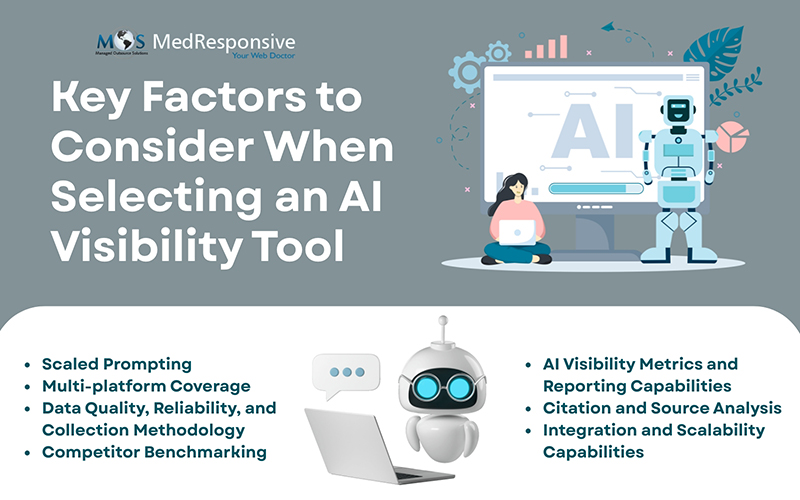AI-driven answer engines such as ChatGPT, perplexity AI, and copilot now influence how people find information, discover brands, and make decisions online. Websites that rank on the first SERP page but don’t appear in any AI responses risk losing visibility and being surpassed by competitors.
But how do you effectively measure the impact of AI search platforms on your content, traffic, and engagement? That’s where an AI visibility tool comes in, monitoring your content performance specifically in AI-generated answers. By tracking your visibility across AI platforms, these tools provide advanced insights that traditional SEO metrics alone can’t capture.
However, with tons of AI visibility tools on the market and a dozen more coming up, choosing the right one for your brand requires understanding key features that make a difference. For companies looking to improve AI search visibility without straining internal resources, partnering with a provider outsourcing digital marketing services can be the most efficient way to leverage AI content insights while focusing on core business priorities.
What Is an AI Visibility Tool?
AI visibility tool, also known as AEO or GEO tool, is designed to help brands and content creators track how their content performs across AI-driven answer engines. Unlike traditional SEO tools that focus on search rankings, these tools monitor how your content is being cited, summarized, or referenced by AI systems. Essentially, it’s about measuring real influence that your brand holds in AI-generated responses, going beyond clicks or visitors of a search results page.
These tools use scaled prompting to generate actionable insights into how AI platforms interact with your content. They help you identify which pages are being surfaced in AI responses, which topics are gaining traction, and where competitors might be outperforming you. With AI-driven content analytics, marketers can optimize content to improve visibility, engagement, and ultimately, influence in a landscape where AI answers are becoming a primary source of information for users.
How to Choose the Best AI Visibility Tool for Your Business
Let’s go through the key factors you need to consider when choosing an AI visibility tool.
- Scaled Prompting
Scaled prompting is all about testing multiple versions of your queries across different AI platforms to see how your content shows up. Since AI models rely on probabilistic reasoning, even identical-looking questions can generate different answers depending on factors such as phrasing, training data, or user context. Manual checks quickly fall short because they cannot capture these fluctuations or provide reliable insights.
An effective AI visibility tool automates large-scale prompting, allowing businesses to run hundreds or even thousands of high-intent queries while also enabling custom prompts. For instance, an AI transcription tool company might test queries such as:
- “Best AI transcription software”
- “Most accurate medical transcription AI”
- “Cost-effective transcription tools”
By analyzing how responses change across these variations, brands can identify the patterns that influence visibility, such as preferred phrasing, topic emphasis, or supporting data. Scaled prompting AI transforms guesswork into systematic analysis, showing when, where, and how AI recognizes and ranks your content.
- Multi-platform Coverage
No single platform dominates the search landscape, and audiences are distributed across multiple engines, assistants, and discovery tools. To understand the full scope of your visibility, multi-platform AI monitoring of your content across ChatGPT, Perplexity, Copilot, Google AI Overviews, and Gemini should be implemented. This is because each system serves different audiences, uses distinct training data, and interprets queries in unique ways.
For example, a brand may find its content consistently surfaces in ChatGPT but not in Gemini or is referenced by Perplexity but absent from Copilot. These gaps matter because focusing on only one platform risks overlooking valuable opportunities. An AI visibility tool with multi-platform coverage provides a unified view of performance, by monitoring where your content appears, how it is interpreted, and which engines deliver the most visibility. Ideally, the tool should also support multilingual queries and domain-specific prompts to ensure global and industry-relevant coverage.
- Data Quality, Reliability, and Collection Methodology
As AI search becomes more prominent, optimizing content for AI discoverability has emerged as the top priority for brands and digital creators. However, accurate insights into your AI visibility depend on the quality of data your AI tool collects. There are two primary ways AEO platforms gather data:
- API-based monitoring: Provides clean, structured information by connecting directly to the AI platform’s source and retrieving real-time data. However, this may have usage limits since user-facing elements such as exact citations, images, or rich formatting are often omitted.
- Scraping: Simulates user queries and captures what appears on screen, including layout and citations, but is more prone to noise and may break when platforms update their interfaces.
Some tools combine both methods, using APIs for precision and scraping for richer context. What matters most is transparency – the tool should clearly explain how it gathers, verifies, and updates data so businesses know they can trust the results. Without reliable data collection methodology, businesses risk basing decisions on incomplete or misleading data, leading to suboptimal outcomes.
- AI Visibility Metrics and Reporting Capabilities
Knowing whether your content appears in AI-generated answers is only the starting point. To make those insights actionable, companies need tools that track brand visibility in AI responses across meaningful metrics, such as:
- AI Traffic
- Share of Voice
- AI Visibility
- Brand Mentions
- Sentiment Analysis
These metrics reveal not just if content is present, but how often, in what context, and with what impact on user perception. However, capturing AI visibility metrics alone is not enough. Reporting capabilities determine whether the data can be effectively applied to decision-making. Look for platforms that offer intuitive dashboards, automated summaries, trend analysis, and team-friendly features such as multi-user access. Combining AI metrics with robust reporting makes it easier to track progress over time, identify hidden opportunities, and align SEO efforts across teams.
- Competitor Benchmarking
Understanding your own visibility is valuable but knowing how you stack up against competitors is where the real strategic advantage lies. Competitor benchmarking tools highlight which queries trigger rival content, how often they are mentioned, and what types of sources improve their visibility. Advanced platforms may even offer:
- Predictive Analytics
- Keyword and Query Overlap
- Competitor Share-of-Traffic Estimates
- Real-time Trend and Gap Detection
- Comprehensive Competitor Analysis
This level of analysis allows businesses to see exactly where competitors are gaining ground and why. It also highlights untapped opportunities, such as queries or content formats that consistently favor rivals. With AI content insights, companies can refine their SEO strategies to recover lost ground, strengthen positioning, and align content with evolving AI preferences. Competitor benchmarking shifts the focus from isolated performance analysis to competitive context, helping brands not only measure visibility but also actively improve market position.
- Citation and Source Analysis
One of the most overlooked aspects of AI visibility is whether your brand is being properly credited when AI systems generate answers. A capable visibility tool not only tracks which content sources influence AI mentions but also provides clarity on how citations are being used across platforms. This includes monitoring whether your original content is directly linked, referenced indirectly through secondary sources, or left out entirely.
For companies publishing high-value research, thought leadership, or industry reports, citation tracking is crucial to ensuring credibility and protecting brand authority in AI-generated answers. For example, a healthcare company might want to verify that its peer-reviewed whitepapers are the primary source being quoted in AI answers rather than competitors who have merely summarized the findings. By identifying gaps in attribution, businesses can implement data-driven content strategy to optimize existing materials and push authoritative content higher in AI-driven responses.
- Integration and Scalability Capabilities
As your organization grows, your AI visibility solution should scale with it. A platform that works only for a handful of tracked queries may quickly become insufficient once coverage expands to multiple markets, languages, or product lines. The most effective solutions offer streamlined integration with existing ecosystems such as analytics dashboards, SEO platforms, and content management systems, so insights can flow seamlessly between teams during day-to-day operations.
Scalability also means handling higher data volumes without sacrificing speed or accuracy. Features like API access, automated workflows, and bulk prompt testing ensure that large teams can manage queries at scale without bottlenecks. For companies with international reach, multi-region and multi-language support becomes equally important to capture visibility across diverse user bases. Choosing a tool with proven scalability helps organizations avoid the disruption of migrating later and ensures that insights remain actionable as AI-driven search continues to expand.

Cut through the AI Noise with External Experts
The era of AI search has ushered in a new landscape where visibility, expertise, and strategy matter more than ever. While AI visibility tools provide valuable insights, implementing and managing these solutions in-house can be resource-intensive, requiring specialized knowledge and constant monitoring. For many brands, building this level of internal capability may divert focus from core business priorities and overwhelm existing teams.
Utilizing affordable digital marketing services is a practical alternative for this concern. External agencies with AI-focused experience bring a combination of technical skill, strategic perspective, and industry knowledge, enabling brands to navigate the complexities of AI search efficiently. They can implement best practices, manage campaigns across multiple platforms, interpret nuanced data, and adjust strategies in real time, without straining internal resources. By collaborating with these experts, companies maintain a strong AI presence, capitalize on emerging opportunities, and focus internal efforts on business growth.




